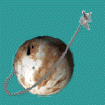
Current Issues:
SpaceViews
SpaceViews Update
Breaking News
Back Issues
Search
Subscriptions
Submissions
Forum
Space Sites of the Week
Home
Early Science from Pathfinder
After just over a week on the surface, Mars Pathfinder has already returned important information about the surface and atmosphere of the Red Planet, including confirming some earlier speculation about events early in Martian history.
Some of the first images returned from Pathfinder confirmed what many planetary scientists had believed since studying the Viking images a generation ago: that the planet had been subjected to catastrophic floods early in its history, torrents of water which flowed across the surface and shaped the landscape in ways visible today.
The Viking images showed what appeared to be signs of water flows on the planet, including teardrop-shaped "islands" which appeared to be shaped by flowing water, and flow channels and basins. One of those areas that had been shaped by water was the Pathfinder landing site, Ares Vallis.
Pathfinder's up-close inspection of the landscape in Ares Vallis have provided additional evidence for powerful floods in ancient Martian history. Large boulders, a meter or more in diameter, are pushed together. Such
placement requires either considerable luck or a force that could have moved the boulders along and then set them down... such as water.
Pathfinder's camera revealed additional evidence. Some rocks, as well as more distant landmasses such as the "Twin Peaks" a kilometer away, show signs of layering, evidence of sedimentary activity associated with water. The ground around Pathfinder also shows a wavelike series of small rises and depressions, also evidence of flowing water. Images also show signs of evaporative deposits, or residue from puddles of water that long since evaporated, in areas of the soil near the lander.
Put together, these pieces of evidence suggest that the surface of Mars, and in particular Ares Vallis, was subjected to catastrophic flooding which one scientist said was only equaled by "the creation of the Mediterranean Sea," which formed as the waters of the Atlantic Ocean streamed through the Straits of Gibraltar.
Quartz and Maghemite
Pathfinder images halve also shown planetary scientists that Martian rocks are more varied than once thought. A concept of a field of identical red rocks, which both Viking landers seemed to show, was broken by images of lightly-colored, almost whitish rocks dubbed "Casper" and "Scooby-Doo". These rocks will be examined by Sojourner in the near future to get a better idea of how they differ in composition than other, more typical, Martian rocks.
The one Martian rock which has been studied in detail, "Barnacle Bill", has provided scientists with surprises as well. The composition of Bill appears to be more like a terrestrial volcanic rock, including evidence for andesite, a igneous rock common to terrestrial volcanoes.
Sojourner also found more free quartz in the rock than predicted, which provided additional evidence that Bill has a volcanic origin. These results were not that different than some of the Martian meteorites that have been studied in terrestrial laboratories, but was considerably different than predicted.
Another surprise came with the Martian soil. Preliminary results from an experiment designed to test for magnetism in airborne Martian dust appear to show, in the view of the lead scientist for the experiment, that all Martian dust is magnetic to some degree. The likely mineral contributing to the magnetism is maghemite, a mineral used on Earth in hard disk drives for computers.
A "Boring" Atmosphere
The Martian atmosphere, on the other hand, has not been interesting -- in fact, one scientist admitted that the Martian weather to date had been "boring!" Average high temperatures have reached about 10 F (-12 C), dropping off at night to -100 F (-73 C) or below. Winds have been very light, with a force not exceeding the equivalent of a 1 mph (1.2 kmph) breeze on Earth.
Once interesting atmospheric result, though, has been a comparison of temperature profiles in the atmosphere at varying altitudes measured by Pathfinder as it descended to the surface. Compared to similar profiles taken 21 years ago by the two Viking landers, they show little difference in temperature below about 60 km (37 mi.) altitude, down to the surface.
Above that altitude, though, and there are differences. Temperatures measured by Pathfinder are considerably colder than those measured by the Vikings at the same altitudes. The temperature reaches a minimum of -170 C (-275 F) at an altitude of 80 km (50 mi.), the coldest temperature ever recorded in the Martian atmosphere. These results will be compared to Hubble Space Telescope observations of the planet in recent years, which seemed to imply that the planet had grown colder since the Viking years.
Over the next several weeks we can expect virtual mountains of new images and other data to arrive from Pathfinder and Sojourner, which may give us a new handle on the differences in the composition of Martian rocks and let us see changes in the Martian weather over time. We should expect new discoveries to come from the Pathfinder data for years to come, long after the mission has ended -- the Viking data is still being used in research today, 21 years after arriving at Mars!
Added to site: 1997 July 14
